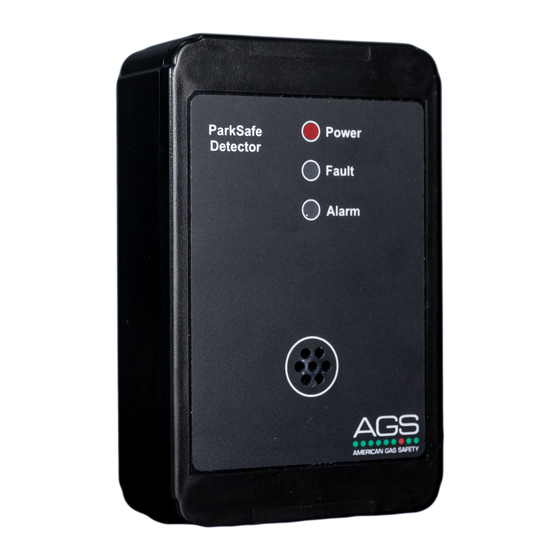AGS Parksafe Control Panel Handbuch für Installation und Betrieb - Seite 11
Blättern Sie online oder laden Sie pdf Handbuch für Installation und Betrieb für Controller AGS Parksafe Control Panel herunter. AGS Parksafe Control Panel 16 Seiten. Ventilation control panel
Auch für AGS Parksafe Control Panel: Handbuch für Installation und Betrieb (16 seiten), Installation, Betrieb und Wartung (16 seiten), Handbuch für Installation, Betrieb und Wartung (20 seiten)

Installation & Operation Manual
Bump Testing
What is Bump Testing?
Bump testing is a term used for checking a gas detector is functioning correctly by exposing it to
the target gas. A known concentration of the target gas is applied to the device to trigger an
alarm condition and ascertain the detector is working safely.
Why is it Important?
A detector may visually appear in good order, but its sensitivity can be inhibited by external
factors such as, dust; humidity; temperature fluctuations; cleaning products; contaminants or
sensor drift (ageing). All can cause a decline in sensitivity and eventual failure.
The aim of the bump test is to make sure a gas detector is working at its optimum by briefly
exposing the unit to a known concentration of the target gas. The reading (if displayed) is
compared to the actual content of gas present, as stated on the test gas cylinder and if the
detector goes into alarm within an acceptable range of the actual concentration, usually within
10%, then it is working safely.
If the bump test results are not within the acceptable range, the gas detector must not be used
until a full calibration has been conducted.
Bump testing has a number of benefits for the end user:
Peace of mind that the system does actually detect the gas in question.
Allows the site to practice safe operations in a similar manner to the fire system.
Early indication of any issues.
How Often?
Regular bump tests are important to make sure the detector is able to detect a release of gas as
early as possible. A bump test usually takes seconds (gas type dependant) and is often
completed alongside a scheduled fire alarm test, however the frequency should be determined
following a risk assessment by the end user.
Current standards recommend that for new installations - it may be prudent to carry out a bump
test frequently (perhaps weekly), following a successful initial period and as confidence grows in
the installation concerned, the frequency could be reduced.
Remember, bump testing does not remove the need to have gas detectors inspected,
calibrated and serviced periodically by a trained engineer.
and should employ the services of a specialist company.
For more information on this, contact us.
AGS Parksafe - IOM Iss: DRAFT 3 06-20
Parksafe Control Panel
You should not attempt this yourself
11
